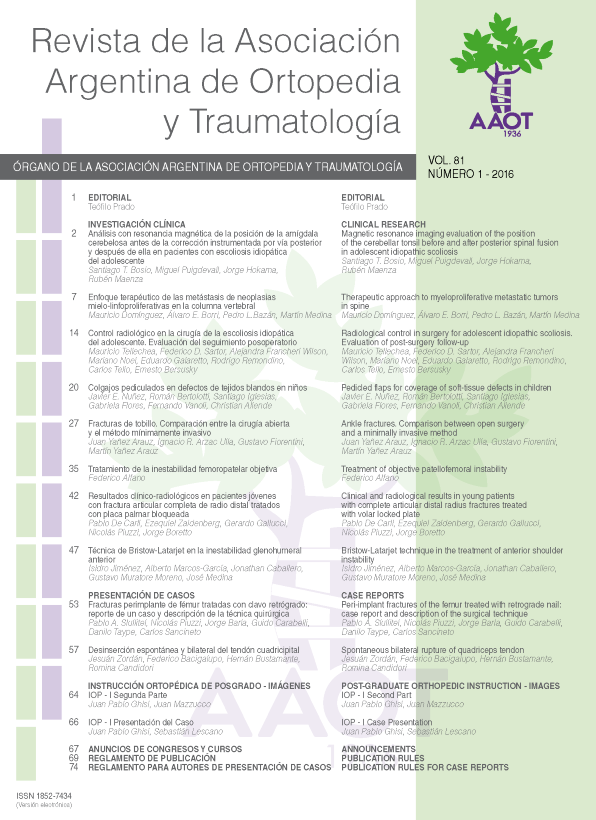Ankle fractures. Comparison between open surgery and a minimally invasive method.
Main Article Content
Abstract
Downloads
Metrics
Article Details

This work is licensed under a Creative Commons Attribution-NonCommercial-ShareAlike 4.0 International License.
Manuscript acceptance by the Journal implies the simultaneous non-submission to any other journal or publishing house. The RAAOT is under the Licencia Creative Commnos Atribución-NoComercial-Compartir Obras Derivadas Igual 4.0 Internacional (CC-BY-NC.SA 4.0) (http://creativecommons.org/licences/by-nc-sa/4.0/deed.es). Articles can be shared, copied, distributed, modified, altered, transformed into a derivative work, executed and publicly communicated, provided a) the authors and the original publication (Journal, Publisher and URL) are mentioned, b) they are not used for commercial purposes, c) the same terms of the license are maintained.
In the event that the manuscript is approved for its next publication, the authors retain the copyright and will assign to the journal the rights of publication, edition, reproduction, distribution, exhibition and communication at a national and international level in the different databases. data, repositories and portals.
It is hereby stated that the mentioned manuscript has not been published and that it is not being printed in any other national or foreign journal.
The authors hereby accept the necessary modifications, suggested by the reviewers, in order to adapt the manuscript to the style and publication rules of this Journal.
References
2. Garrigues G, Glisson R. Can locking screws allow smaller, low-profile plates to achieve comparable stability to larger, standard plates? J Orthop Trauma 2011;25(6):347-54.
3. Hughes JL, Weber H, Willenegger H, Kuner EH. Evaluation of ankle fractures: non-operative and operative treatment. Clin Orthop Rel Res 1979;138:111-9.
4. Minihane K, Lee C, Ahn C. Comparison of lateral locking plate and antiglade plate for fixation of distal fibular fractures in osteoporotic bone. A biomechanical study. J Orthop Trauma 2006;20(8):562-6.
5. Stufkens S,Van den Bekerom M, Kerkhoffs G. Long term outcome after 1822 operatively treated ankle fractures: A systematic review of the literature. Injury-Int J Care Injured 2011;42:119-27.
6. Yablon IG, Heller FG, Shouse L. The key role of the lateral malleolus in displaced fractures of the ankle. J Bone Joint Surg Am 1977;59:169-73.
7. Hess F, Sommer C. Minimally invasive plate osteosynthesis of the distal fibula with the locking compression plate: First experience of 20 cases. J Orthop Trauma 2011;25:110-5.
8. Bloomstein L, Schenk R, Grob P. Percutaneous plating of periarticular tibial fractures: a reliable, reproducible technique for controlling plate passage and positioning. J Orthop Trauma 2008;22(8):566-71.
9. Collinge C, Sanders R, DiPasquale, T. Treatment of complex tibial periarticular fractures using percutaneous techniques. Clin Orthop Relat Res 2000;375:69-77.
10. Ozkaya U, Parmaksizoglu A, Gul M. Minimally invasive treatment of distal tibial fractures with locking and non locking plates. Foot Ankle Int 2009;30(12):1161-7.
11. Ruedi TP, Buckley RE, Morgan CG. AO Principles of fracture management. Pathophysiology, evaluation, and classification of fractures; AO Foundation Publishing; 2007.
12. Tornkvist H, Hearn TC, Schatzker J. The strength of plate fixation in relation to number and spacing of bone screws. J Orthop Trauma 1996;10(3):204-8.
13. Yañez Arauz JM. Osteosíntesis mínimamente invasiva en fracturas del peroné distal. Rev Asoc Argent Ortop Traumatol 2005;70(2):136-45.
14. Bauer M, Bengner U, Johnell O, Redlund Johnell I. Supination-eversion fractures of the ankle joint: changes in incidence over 30 years. Foot Ankle 1987;8(1):26-8.
15. Hahn DM, Colton CL. Malleoli. En: Ruedi TP, Buckley RE (eds). AO Principles of fracture management, 2nd ed. New York: AO Publishing, Thieme; 2007:870-97.
16. Chapman MW. Fracture and fracture dislocation of the ankle. En: Mann RA, Coughlin MJ. Surgery of the foot and ankle, 6th ed. St Louis: Mosby; 1993:1464-93.
17. Burwell HN, Charnley AD. The treatment of displaced fractures at the ankle by rigid internal fixation and early joint movement. J Bone Joint Surg Br 1965;47:634-60.
18. Farouk O, Krettek C, Miclau T, Schandelmaier P, Guy P, Tscherne H. Minimally invasive plate osteosynthesis and vascularity: preliminary results of a cadaver injection study. Injury 1997;28(Suppl 1):A7-A12.
19. Rhinelander FW. The normal microcirculation of diaphyseal cortex and its response to fracture. J Bone Joint Surg Am 1968;50784-800.
20. Robinson CM, McLaughlan GJ, McLean IP, Court-Brown CM. Distal metaphyseal fractures of the tibia with minimal involvement of the ankle. Classification and treatment by locked intramedullary nailing. J Bone Joint Surg 1995;77(5):781-7.
21. Yañez Arauz JM. Osteosíntesis mínimamente invasiva del maléolo peróneo. Flamecipp 2012;2(1):37-46.
22. Fink B, Mizel MS. What’s news in foot and ankle surgery? J Bone Joint Surg Am 2002;84(3):504-9.
23. Shah NH, Sundaram RO, Velusamy A, Braithwaite IJ. Five year functional outcome analysis of ankle fracture fixation. Injury 2007;38:1308-12.
24. Colvin AC, Walsh M, Koval KJ, Mc Laurin T, Tejwani N, Egol K. Return to sports following operatively treated ankle fractures. Foot Ankle Int 2009;30(4):292-6.
25. Kennedy JG, Johnson SM, Collins SL, Dallo Vedova P, Mc Manus WF, Hynes DM, et al. An evaluation of the Weber classification of ankle fractures. Injury 1998;29:557-80.
26. Tejwani NC, Mc Laurin TM, Walsh M, Bhadsavle, Koval K, Egol K. Are outcomes of bimalleolar fractures poorer than those of lateral maleolar fractures with medial ligament injury? J Bone Joint Surg Am 2007;89:1438-41.
27. Khurana S, Raj Karia, Kenneth A. Operative treatment of no union following distal fibula and medial maleolar ankle fractures. Foot Ankle Int 2013;34(3):365

